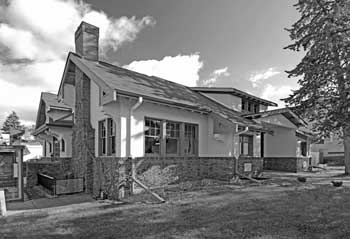Small Home Gazette, Fall 2010
How to Recycle a Building
Some buildings are admirably suited to reuse. Factories and warehouses, built on the open plan, are easy to adapt. So are firehouses. Firehouses have private spaces for sleeping, public spaces for eating and socializing, and open spaces where the firetrucks used to fit. In Minneapolis and St. Paul alone, decommissioned firehouses have become restaurants, dance studios, and pottery showrooms.
But my favorite repurposed firehouse in Minneapolis has been most ingeniously recycled by its new occupants—architects.
 The Minneapolis Fire Station at 42nd Street and Cedar Avenue, built in 1923, looks like the Craftsman bungalows that surround it; only the bright red doors indicate its purpose. It served a quiet neighborhood, where firefighters were more likely to rescue cats from trees than children from burning buildings. It also was a community center, holding dances and Golden Gloves competitions for neighborhood youth.
The Minneapolis Fire Station at 42nd Street and Cedar Avenue, built in 1923, looks like the Craftsman bungalows that surround it; only the bright red doors indicate its purpose. It served a quiet neighborhood, where firefighters were more likely to rescue cats from trees than children from burning buildings. It also was a community center, holding dances and Golden Gloves competitions for neighborhood youth.
When the city decommissioned the firehouse in the 1980s, they leased it to Hennepin County, which garaged emergency vehicles in the old firetruck space.
The city had plans for the building. When it passed its 80th birthday, the Minneapolis Historic Preservation Commission nominated it for the National Register of Historic Places. Only then did they put it on the market.
They found the ideal buyer—the firm of HCM Architects, which looked forward to preserving the firehouse’s character.
The former garage has become an open working space; the old sleeping rooms are now individual offices; and the old dispatcher’s room, where the calls came in, has become the space that houses the computer server. The living room, with its homey brick fireplace, is now a comfortable meeting room.
Jerry Hagen, Roger Christensen and Tim McIlwain, the firm’s principals, have adapted the building beautifully for the firm’s purposes. It’s now a repository for the building’s former history, including plans, elevations, and artifacts like fire hats, hoses, and hatchets. Visiting it always delights one of their biggest clients—the Minneapolis Fire Department.











